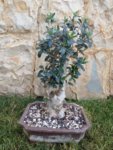maroun.c
Omono
3-4 years back I started with few bonsais, moslty olives and struggled with soil issues and sourcing out good soil material as well as watering.and few other issues. Luckily I have found some good soil that has been working for an least 2 years for few olives (pumice and some clay balls) and looks I'll be getting some Acadama as well soon...
So basically I have a few olives that has made it fine fro the last 18-24 months at least in that soil.
So it is time to start experimenting with those in planning a style to grow them in. I have been on travel for most of last year years so except for watering and the very occasional fertilizer they didn't get any care. I will start fertilizing a bit more frequent to boost their growth a bit.
These 3 trees are far from good material I agree but that's the i could find here and would love to try to get something half decent out of them.
will post pics of all three trees from 4 sides and appreciate yuor time in helpign with a plan for each.
Tree 1
Current front

Rt side

Back

Lt

Size wise this is the most promising of my trees but the 2 huge branches got me confused on what to do on it. Also the barck of the trunk is still two white and looks too New to wonder how long g it'll take to look older.
Tree 2
Front.

Rt side

Back

Lt

Tree 3
Front

Rt
So basically I have a few olives that has made it fine fro the last 18-24 months at least in that soil.
So it is time to start experimenting with those in planning a style to grow them in. I have been on travel for most of last year years so except for watering and the very occasional fertilizer they didn't get any care. I will start fertilizing a bit more frequent to boost their growth a bit.
These 3 trees are far from good material I agree but that's the i could find here and would love to try to get something half decent out of them.
will post pics of all three trees from 4 sides and appreciate yuor time in helpign with a plan for each.
Tree 1
Current front

Rt side

Back

Lt

Size wise this is the most promising of my trees but the 2 huge branches got me confused on what to do on it. Also the barck of the trunk is still two white and looks too New to wonder how long g it'll take to look older.
Tree 2
Front.

Rt side

Back

Lt

Tree 3
Front

Rt













